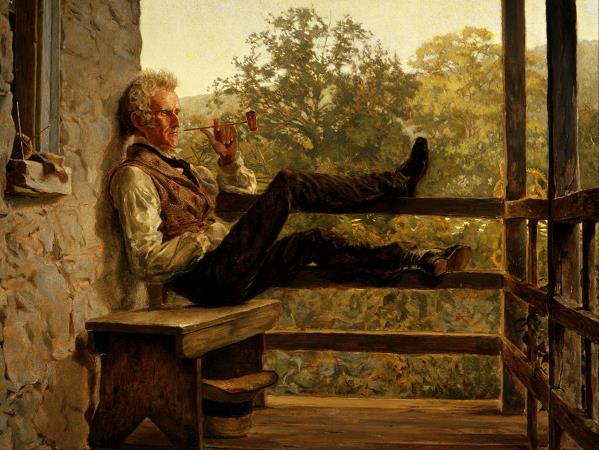Francis Blackwell Mayer (1827 - 1899). Francis Blackwell Mayer was a prominent 19th-century American genre painter from Maryland. While he spent most of his life in that state, he took a trip to the western frontier in the mid-nineteenth century and executed a series of drawings of Native Americans; he also studied in Paris for five years in the 1860s. Primarily known for his oil paintings and watercolors, he also worked in other media, including pen and crayon drawings, engraving, and illustrating. Many of his work have historic themes. Francis Blackwell Mayer was born in Baltimore, Maryland, on December 27, 1827, the son of Charles Mayer and Eliza Blackwell Mayer. He was one of three sons, Henry Christian Mayer, the son of his father with his first wife, and Alfred M. Mayer, who became a noted physicist, being the other two. An uncle, Brantz Mayer, was a noted author. Frank Blackwell Mayer studied art in Baltimore with Alfred Jacob Miller and Ernest Fischer in the 1840s and in Paris with Charles Gleyre and Gustave Brion between 1864 and 1869, specializing in oil paintings and crayon drawings. He lived in Paris from 1862 to 1870, where his artwork was exhibited at annual expositions in both London and Paris. Frank Blackwell Mayer in 1851, drawing by Ashton White Frank B. Mayer began his work to form the Maryland Art Association on March 14, 1847 and the association met in his studio once a week. He went on to work as an engraver in Philadelphia in 1847 and in 1848 served as the assistant librarian for the Gallery of Fine Arts at the Maryland Historical Society, which his uncle author Brantz Mayer, was heavily involved with, both in its founding and as president. He also made illustrations for his uncle's books on Mexico. Mayer went on to form the Allston Association with friends for the appreciation of American Artists. Its constitution outlined the usual club regulations and allowed ladies as auxiliary members and outlined the plans for art exhibitions and for assistance given to native artists. He also served on the club's Board of Directors. In May 1851, Mayer travelled to Minnesota Territory and observed the signing of the Treaty of Traverse des Sioux. He wrote extensive journals and made pen and ink drawings of his experiences in the west. This experience was the influence for one of his most famous paintings, Treaty of Traverse des Sioux, Minnesota from 1886. Upon his return to Maryland, ten of his watercolors were exhibited by the Artist's Association of Baltimore at the Maryland Historical Society in 1856. After his education in Europe, Mayer received a medal and diploma from the Maryland Institute for his works Continental and Attic Philosopher. Upon his return to the United States, he settled in Annapolis, Maryland, and resided on Market Street while keeping a studio on Prince George Street.
more...





